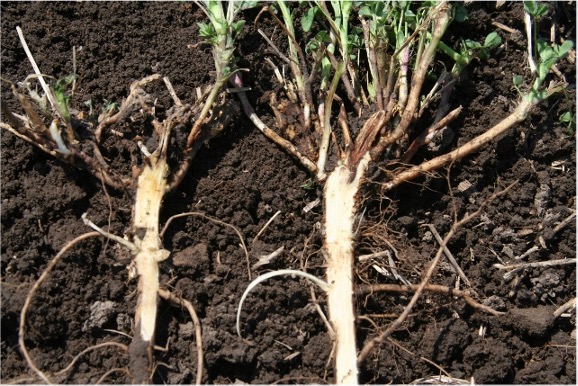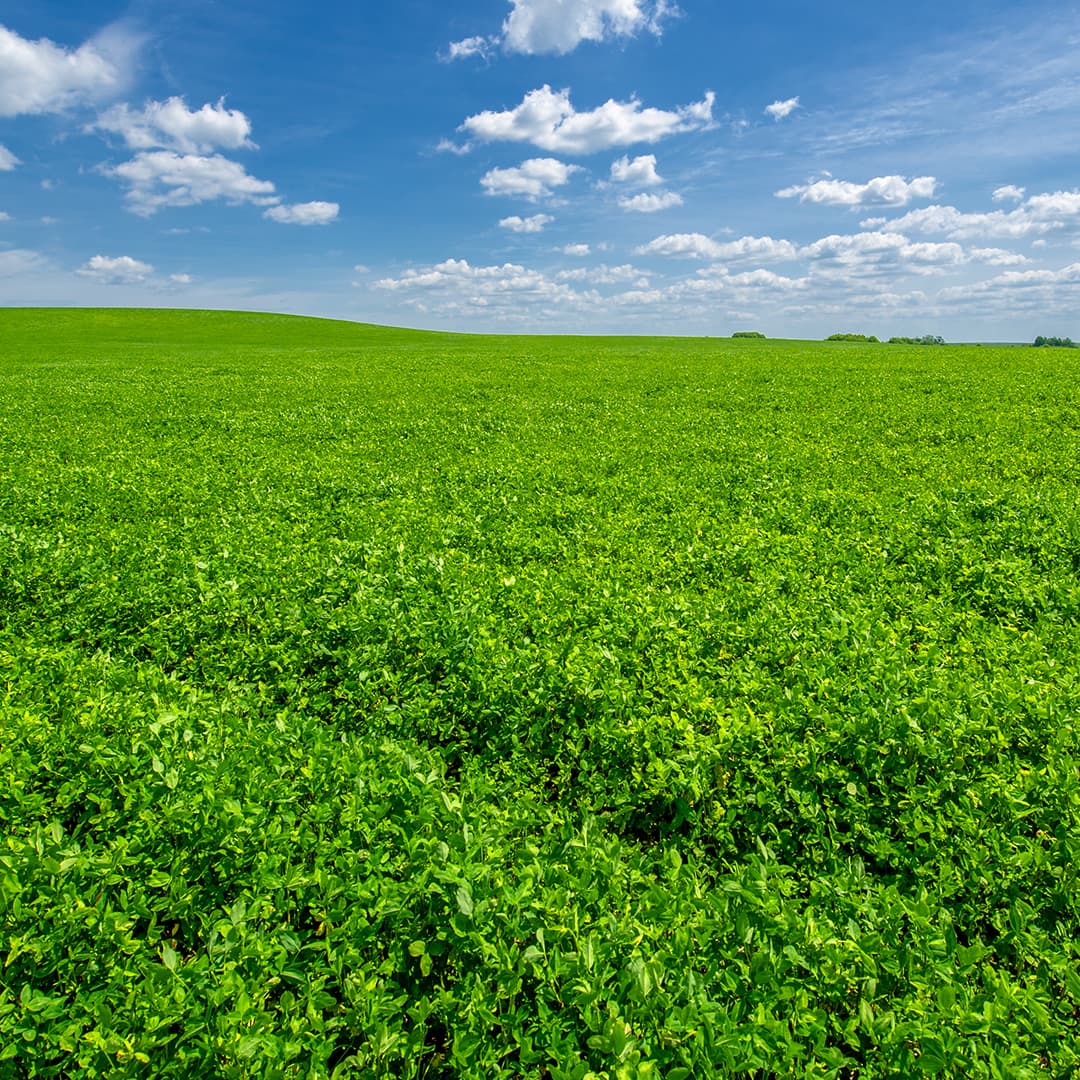To inform early planting decisions, it is important to check your alfalfa fields each spring for winter damage. Injured fields that exhibit signs of winter kill may need to be reseeded or rotated and injured fields without kill may need to be considered for turnover to utilize nitrogen and rotational benefits to the next crop.
If reseeding alfalfa within one to two years of killing the previous stand, be aware that a stand of alfalfa releases autotoxic compounds into the soil that inhibit alfalfa regrowth. How long these compounds remain is a function of soil type, temperature, amount of rainfall and time from tillage to reseeding. These residues affect only alfalfa and will reduce future yield by up to 60% if reseeded within one year of killing the stand and 15 to 20% if reseeded in 1 to 2 years on medium to heavy soils.
When making decisions for the long term, use stem counts to estimate future yield potential. Stand yield potential based on stem densities per square foot can be assessed in the following manner:

Example: Injured and dying plant on left (yellow taproot below the crown) and a healthy plant on right.

Example: Dead plants with dehydrated, yellow-brown areas below the crown.
How do we identify injured and killed alfalfa early?
Most alfalfa will survive winter in good condition. However, alfalfa may show signs of winter damage in areas that lack snow cover in winter, especially in fields with low soil pH, low potassium and sulfur or older stands. Look for these signs when examining your alfalfa for winter kill.- Root damage. Healthy roots are firm and white. Injured roots are spongy, yellowish-grey and dehydrated. Over time, injured roots will become diseased, rot and turn dark brown. A damaged root cannot sustain crown bud growth.
- Slow or no green up in all or some areas of the field. Look for areas of the field that remain brown while others are greening up. Brown areas indicate where plant energy reserves are too low for the spring growth of shoots. Injury can largely destroy the roots and crowns. The crown buds that survive and slowly regrow may be limited to a few per plant and these may be stunted or chlorotic (yellow). Yellow shoots may begin to grow up to 3 inches and then die, while taller shoots will likely survive.
- Uneven regrowth. Damage to several crown buds during the winter will create uneven regrowth as the surviving buds begin to grow and the plant begins to regenerate new crown buds. In this case, the stand may survive but the first cutting will be reduced.
What should we do if we see signs of winter injury or kill?
- Determine if dead spots are dead, not just delayed. Stands can be slow to recover when injured so it is important you do not rush to till up a stand until you have examined the roots to determine health.
- Dig up a few plants and check the top 4 inches of the taproot for color and turgor. Split the root and crown. A healthy taproot should be off-white, like the inside of a potato, and turgid instead of ropy. See the reference pictures below.
- Check plants that are producing small shoots. Sometimes dying plants will produce shoots 1 to 2 inches tall and then die. Again, dig a few plants and look for off‐white and turgid taproots.
- Determine the percentage of the field affected and manage to meet your goals.
- If a small percentage of the field is affected, go over the affected areas with a drill, seeding (10 lbs./a) with a 50/50 mix of Italian annual ryegrass and perennial ryegrass to a depth of ½ inch.
- Alternatively, red clover can be seeded if the stand is to be harvested for haylage. Red clover dries slower than alfalfa and mixtures are difficult to get sufficiently dry for hay. Then harvest the field when the alfalfa is ready for high-quality yield.
- With high nitrogen fertilizer prices, consider that there may be more benefit from taking benefits of turning over the stand rather than keeping a reduced yielding field.
- If a moderate percentage of the field is affected, you can immediately seed Italian ryegrass (10 lbs./a), take the first cutting for forage, then spray and seed corn or soybeans into the killed forage. An alternative to this approach is to take two forage harvests and seed oats for fall forage.
- If a moderate or large amount of the field is affected, seed oats (2 bu/a) and peas (20 lbs./a) for haylage harvest. In some regions, corn, sorghum or sorghum-sudangrass can be planted following the oat-pea harvest.
- If a large percentage of the field is affected, seed corn, BMR sorghum or BMR sorghum‐sudangrass before July 1 (20 lbs./a). These crops can use the nitrogen credits from alfalfa. Corn will likely produce the most tonnage of any forage. Sorghum‐sudangrass is a good choice if you expect dry conditions or above average temperatures. Alfalfa can be seeded into a different field.
Additional considerations for reseeding alfalfa and long-term planning
If reseeding alfalfa within one to two years of killing the previous stand, be aware that a stand of alfalfa releases autotoxic compounds into the soil that inhibit alfalfa regrowth. How long these compounds remain is a function of soil type, temperature, amount of rainfall and time from tillage to reseeding. These residues affect only alfalfa and will reduce future yield by up to 60% if reseeded within one year of killing the stand and 15 to 20% if reseeded in 1 to 2 years on medium to heavy soils.When making decisions for the long term, use stem counts to estimate future yield potential. Stand yield potential based on stem densities per square foot can be assessed in the following manner:
- Greater than 55 stems/ft2 indicates density will not be a limiting factor.
- Between 40 and 55 stems/ft2 indicates some yield reduction but fields may be adequate in years of low inventories and high value.
- Fewer than 40 stems/ft2 indicate a poor stand and consideration for termination.

Example: Injured and dying plant on left (yellow taproot below the crown) and a healthy plant on right.

Example: Dead plants with dehydrated, yellow-brown areas below the crown.



